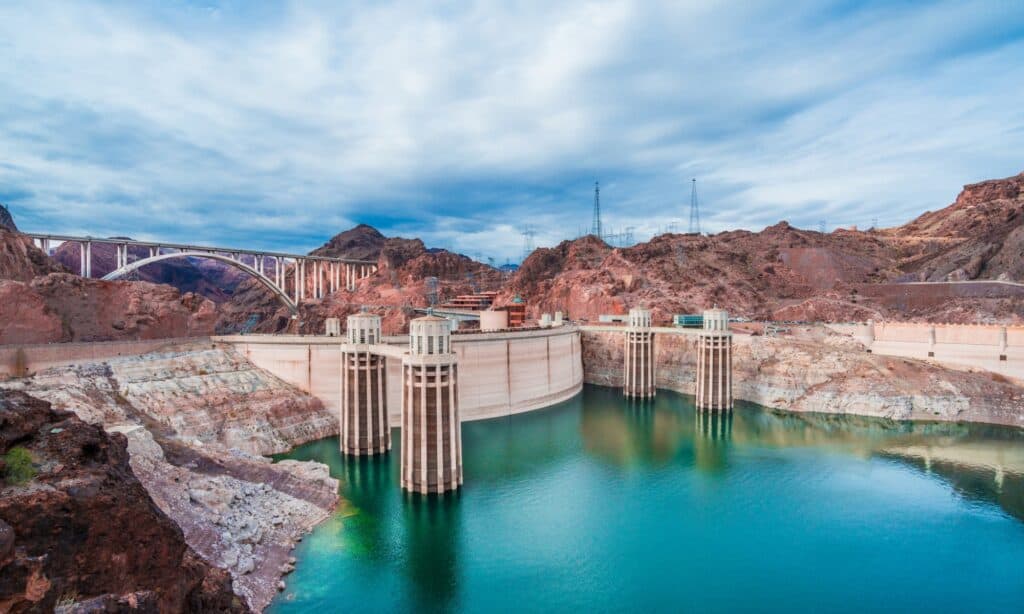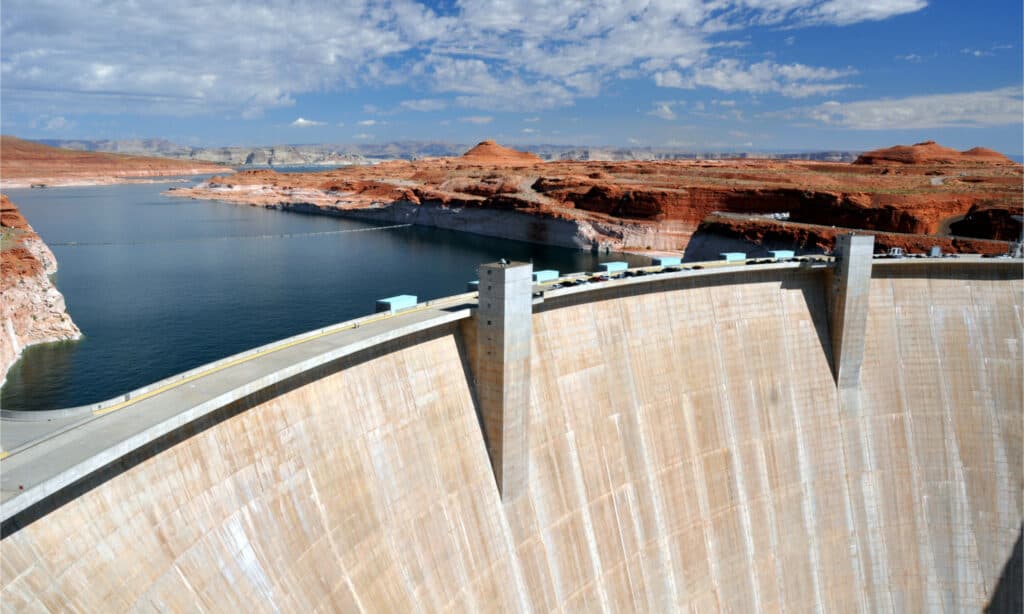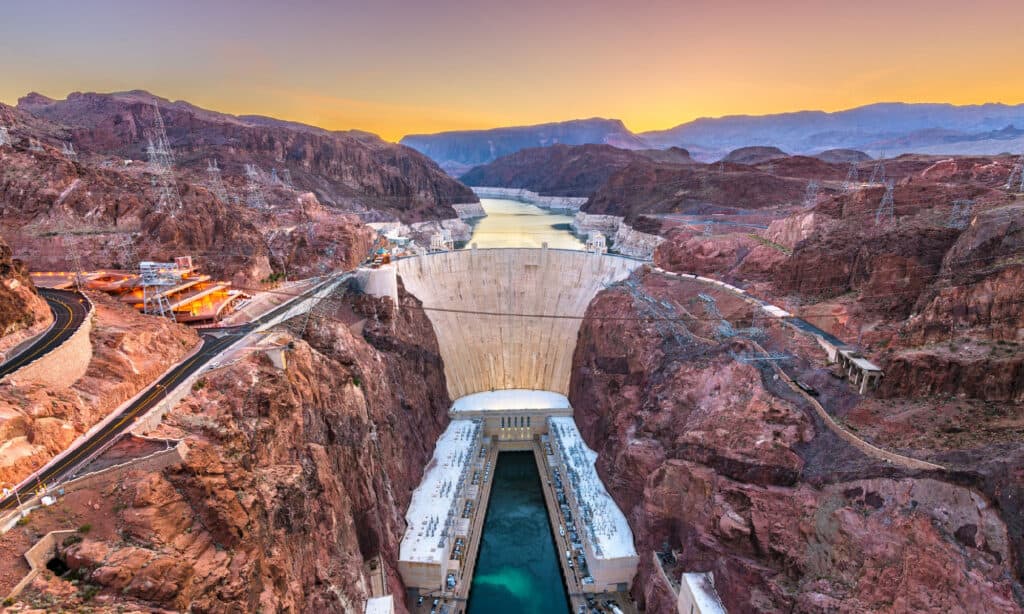An arch-gravity dam made of concrete is what describes Hoover Dam. It lies in the Colorado River’s Black Canyon, on the boundary between Nevada and Arizona in the United States.
President Franklin D. Roosevelt dedicated it on September 30, 1935, after it was built between 1931 and 1936 during the Great Depression. The dam created a reservoir known as Lake Mead, which provides water to farmland, industries, and millions of people in Nevada, Arizona, California, and Mexico.
Each year, Hoover Dam generates around 4 billion kilowatt-hours of hydroelectric power for usage in Nevada, Arizona, and California, enough to power 1.3 million people. From 1939 through 1949, the Hoover Powerplant was the world’s largest hydroelectric facility and is still one of the country’s largest today.
What is the Efficiency of Hydroelectric Power?
Hydroelectric power plants have a high-efficiency rate, and modern hydro turbines may convert up to 90% of the energy available into electricity.
Compared to water, fossil fuel-fired plants can only convert about half of the available energy into electricity at best, emitting harmful pollutants into the atmosphere. Water is a naturally occurring resource, so there are no concerns about fluctuating prices, transportation issues, or production strikes.
The Hoover Dam, in this scenario, stores a large amount of water in a reservoir behind it. A water inlet is located towards the bottom of the dam wall. Due to gravity, water falls through a sluice inside the dam called a penstock.
The fast-moving water rotates a turbine placed at the end of the penstock, and the generator receives the turbine shaft and generates power.
The generator is linked to power lines that distribute electricity to homes and businesses throughout a region. The amount of energy generated is determined by the dam’s size. It’s a lot in the case of the Hoover Dam!
Animals Found at the Hoover Dam

Desert
bighorn sheep
are found at the Hoover Dam
©iStock.com/twildlife
The Hoover Dam, one of the most impressive engineering feats in modern history, is home to a wide variety of wildlife. Located on the Colorado River in the desert Southwest, this area is known for its unique and diverse ecosystems.
Here are three animals commonly found at the Hoover Dam:
- Desert bighorn sheep: These impressive mammals are known for their iconic curved horns and are adapted to living in the harsh desert environment surrounding the Hoover Dam. They are skilled climbers and can be seen scaling the steep cliffs and rocky terrain in the area.
- Canyon wren: The canyon wren is a small bird that is known for its distinctive, loud song. These birds are often found near rocky outcroppings and cliffs, where they build their nests in small crevices and cracks.
- Gila monster: The Gila monster is a venomous lizard that is found throughout the Southwest, including the area around the Hoover Dam. These slow-moving reptiles are known for their distinctive orange and black markings and their venomous bite, which they use to subdue their prey.
In addition to these three animals, many other species of birds, mammals, and reptiles can be found in and around the Hoover Dam.
Visitors to the area are encouraged to respect these animals and their habitats by observing them from a safe distance and not disturbing their natural behaviors.
How Was the Hoover Dam Constructed?

Hoover Dam was built during the Great Depression.
©iStock.com/superjoseph
The construction of Hoover Dam was a bold and risky enterprise. The dam, built during the Great Depression to regulate the flood-prone Colorado River southeast of Las Vegas, would go on safeguard cities and farms, generate affordable electricity for households and industry, and provide work for thousands of people who needed it.
Six Companies Inc. won the contract to build the concrete arch dam for almost $49 million, a huge sum in the early 1930s (roughly $860 million now). It was deemed impossible by skeptics, and others believed the contractors would go bankrupt. But the members of the Six Companies forged on, relying on their extensive aggregate expertise and experience to manage enormous risks and pioneer new territory.
The dam was built with the help of around 5,000 people. The lowest hourly wage was 50 cents, and the highest hourly wage was $1.25. The average hourly salary for all dam workers was around 62.5 cents. After assessing the area and deciding on Black Canyon as the site for the dam, explosives were employed to blast the canyon’s sides away to make room for construction.
Four diversion tunnels were created during the dam’s construction to reroute the water. It took only over a year to dredge the canyon’s bottom, blast and remove rubble, and dig the foundation.
Working on the dam entailed long days and perilous work. In the summer, temperatures reached 120 degrees (just over 48 degrees Celsius) and dropped well below freezing in the winter. The use of explosives and blasting during construction and the digging and construction in the desert sand resulted in poor air quality on site. In 1961, workers went on strike for a portion of the summer.
Since they were blasting through bedrock and creating diversion tunnels at the time, they demanded ice-cold water, flush toilets, and that the Six Companies observe mining laws.
Despite these difficulties, employment at the dam was in high demand. In 1929, some men and their families relocated to Nevada in the hopes of securing work. Because the dam was built during the Great Depression, the prospect of long-term employment – no matter how hazardous – was alluring.
In the middle of nowhere, entire families lived in makeshift dwellings and hastily constructed communities. Boulder City, Nevada, was built to house all of the job’s contractors and their families.
Why Is It Called Hoover Dam?

Hoover Dam was named after US 31st President Herbert Hoover.
©Matej Hudovernik/Shutterstock.com
“What’s in a name?” Shakespeare’s Juliet famously asked. Regarding the Hoover Dam, there seem to be a lot of controversies! The Boulder Canyon Dam Project was born after surveyors advised building the dam in Boulder Canyon. Even after Black Canyon was chosen as a suitable location for the rebuilt project, it was still known as Boulder Dam.
However, at a ceremony in Nevada on September 17, 1930, to commemorate the start of work on a railroad line to the dam site, Secretary of the Interior Ray Lyman Wilbur announced that the dam would be named after US President Herbert Hoover, who was inaugurated in 1929.
When Herbert Hoover was succeeded in the White House by Franklin D. Roosevelt in 1933, the new Secretary of the Interior, Harold Ickes, who was not a fan of Hoover, stated that the structure would be renamed Boulder Dam.
By then, Herbert Hoover’s name had acquired a negative connotation among many Americans, who blamed him for the Great Depression.
In the years since, the names Hoover Dam and Boulder Dam have been interchanged, with the speaker’s preference dependent on their political leanings. President Harry Truman finally approved a congressional resolution naming the dam after Hoover in April 1947.
What is the Hoover Dam’s Purpose?

The Hoover Dam was built to provide irrigation water and hydroelectric power.
©iStock.com/Sean Pavone
Completed in 1936, Hoover Dam was built to provide irrigation water and hydroelectric power, as well as to regulate seasonal flooding of the Colorado River, allowing for downstream settlement. Today, Hoover Dam is one of the United States’ tallest dams, a National Historic Landmark that attracts visitors from all over the world, and a vital reservoir that provides flood control, water storage, and irrigation along the lower Colorado River.
What if the Hoover Dam Breaks?
A catastrophic amount of water from Lake Mead would be unleashed if disaster struck the Hoover Dam and unexpectedly broke. That much water would cover 10 million acres (4 million hectares) at a depth of one foot (30 centimeters).
The heaviest damage would occur downstream, with the potential loss of life dependent on the amount of notice given before the wave. Laughlin, Nevada; Needles, California; Lake Havasu, Arizona; even as far south as Yuma, Arizona; San Luis Rey, Colorado; and a Mexican border community are among the towns that would greatly suffer.
The loss of irrigation water supplies would also have a devastating impact on farming in the area. Farmers in the Imperial Valley rely on the Colorado River for most of their water; their irrigation systems would collapse without it. The Imperial Valley was a bleak desert before irrigation, and it now has over half a million acres of farmland and generates over a billion dollars worth of fruits and vegetables each year.
There’s also the electricity grid to consider. The Hoover Dam was built primarily for hydropower generation, and in fact, it paid not only for the project but also for the dam’s operation, maintenance, and replacement.
One of the most significant disadvantages of hydroelectric power is that the dams that generate it must be built in hilly or mountainous locations (which is why there are no dams in a flat state like Florida). Dam breakdowns happen all the time, and the consequences are always disastrous.
Is the Hoover Dam the World’s Tallest Dam?
The Usoi Dam on the Murghab River in Tajikistan is currently the world’s tallest dam. It stands at a height of 1,860 feet (567 meters), while Hoover Dam stands at a height of 726.4 feet (221.3 meters). Hoover Dam is still among the world’s top 20 tallest dams, but only in the concrete gravity and arch categories. Many other rock and earth-filled dams are taller than Hoover.
The Oroville Dam on the Feather River in California is the only dam in the United States that is taller than Hoover Dam and stands 770 feet (235 meters) tall, but it is an earth-filled dam, not a concrete structure like Hoover.
Is Hoover Dam a World Wonder?
The American Society of Civil Engineers named Hoover Dam one of the Seven Modern Engineering Wonders. It is 726 feet tall, 1,244 feet long at its summit, and 660 feet thick at its base.
The dam’s construction narrative is fascinating. A concrete structure of this magnitude had never been built before, and many techniques utilized to make it were untested. Despite the difficulties, it was handed over to the federal government more than two years before schedule.
The Hoover Dam is a world wonder that deserves to be seen, if not for its history, then for its unwavering mechanics. It demonstrates man’s power to control nature. The Colorado River has been tamed, and its water is used to generate electricity. After all, this is the river that carved the Grand Canyon.
The photo featured at the top of this post is © Edwin Verin/Shutterstock.com
Thank you for reading! Have some feedback for us? Contact the AZ Animals editorial team.







